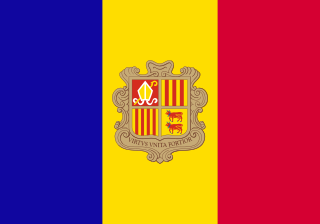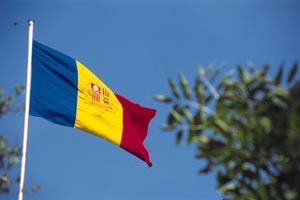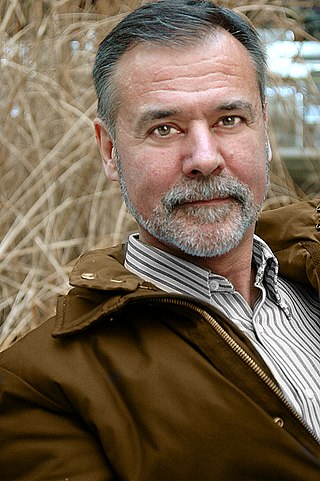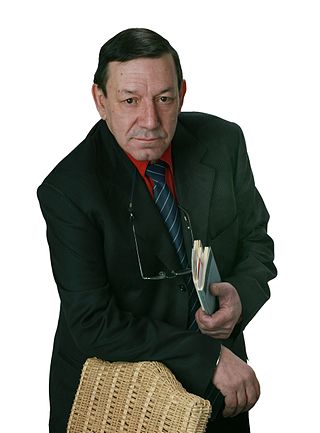Related Research Articles

Andorra, officially the Principality of Andorra, is a sovereign landlocked country on the Iberian Peninsula, in the eastern Pyrenees, bordered by France to the north and Spain to the south. Believed to have been created by Charlemagne, Andorra was ruled by the count of Urgell until 988, when it was transferred to the Roman Catholic Diocese of Urgell. The present principality was formed by a charter in 1278. It is currently headed by two co-princes: the bishop of Urgell in Catalonia, Spain and the president of France. Its capital and largest city is Andorra la Vella.
Andorra, officially the Principality of Andorra, also called the Principality of the Valleys of Andorra, is a sovereign landlocked microstate in Southwestern Europe, located in the eastern Pyrenees mountains and bordered by Spain and France.

"El gran Carlemany" is the national anthem of the Principality of Andorra. Enric Marfany Bons composed the music, while the lyrics were authored by Joan Benlloch i Vivó, written in a first-person narrative from the point of view of Andorra. It was adopted as the national anthem on 8 September 1921, which is also the national day of Andorra. The lyrics make reference to several key aspects of Andorran culture and history, such as the heritage of the Carolingian Empire.

Marc Forné i Molné was the prime minister of Andorra from 7 December 1994 to 20 February 2005. After 2 full terms, he was succeeded by Albert Pintat after Pintat won the January 2005 election. He is a lawyer by profession, and was president of the Liberal Party of Andorra.
Andorra is essentially Catalan speaking. The country has contributed significantly to the Catalan heritage.

La Massana is one of the seven parishes of the Principality of Andorra. It is located in the northwest of the country. La Massana is also the name of the main town of the parish. The name Massana derives from the Latin name mattianam for a variety of apple. Other settlements in the parish are Pal, Arinsal, Erts, Sispony, Anyós, L'Aldosa de la Massana, Puiol del Pui, Escàs, Els Plans, Mas de Ribafeta, Xixerella and Pui.

Canillo is one of the parishes of Andorra. Canillo is also the name of the main town of the parish. The parish is considered the religious center of Andorra with the Sanctuary and Chapel of Our Lady of Meritxell, patron saint of Andorra, and contains one of the best-preserved romanesque churches in the Pyrenees, Sant Joan de Caselles. It has a population of 4,826, as of 2011. Despite having a tourist vocation, the parish of Canillo still retains many livestock and agricultural traits.

Ordino is the most northerly parish in the Principality of Andorra. It's mostly the main area of Valira del Nord or Valira d'Ordino river valley. Ordino is also the name of the main town of the parish. Other settlements in the parish are El Serrat, Ansalonga, Sornàs, La Cortinada, Llorts, Segudet, Arans, Les Salines and Arcalís. It is home to the Sorteny National Park, the largest nature area of Andorra. It has a population of 4,858, as of 2017. The town preserves a vast medieval center, mainly linked to the culture of the country.

Albert Salvadó i Miras was an Andorran writer and industrial engineer. He wrote in both Catalan and Spanish.

Andorra is a Christian majority country, with Islam being a minority religion. According to the US Religious Freedom Report of 2006 there are about 2000 North Africans currently living in Andorra and they are the largest Muslim group in the country.

The Andorra National Library was founded in 1930, then re-opened in 1974. Since 2020, it is housed in the former Hotel Rosaleda in Encamp.

Casa de la Vall is a historical house in Andorra la Vella, Andorra. It is former headquarters of the General Council of Andorra. It lies just to the southwest of the Andorra National Library. It is a heritage property registered in the Cultural Heritage of Andorra.

Antoni Morell Mora was a Spanish-born Andorran diplomat, civil servant, writer and lawyer.
The law of Andorra includes customary law and legislation.
The Josep Pla Award is a Spanish literary prize, awarded by the Destino publishing house since 1968, to a prose text written in Catalan. It is open to all genres: novel, short story, narrative, travel book, memoir, biography, diary, etc. Its name pays tribute to Josep Pla, considered one of the most important prose writers of contemporary Catalan literature.
Events in the year 2020 in the Principality of Andorra.
Lídia Armengol i Vila was an Andorran historian and civil servant who championed the restoration of her country's historic language and culture.
Teresa Colom i Pich is an Andorran author and poet.
Elidà Amigó i Montanya was an Andorran historian, archivist, activist, and suffragist. A leader in the feminist movement that led to Andorran women gaining the right to vote in 1970, she was also an academic expert on the history and sociology of the microstate of Andorra. She has been described as "the first Andorran intellectual to bring critical awareness to the condition of women" in the principality.
References
- Canturri, Pere (1998). "Història i llegenda del Manual Digest". Manual Digest : 250è aniversari. Andorra: Govern d'Andorra. Ministeri de Cultura i Turisme. ISBN 9789992002049.
- Fernández González, Júlia (2014). "Fra Tomàs Junoy, "Lo Peripatètic Solitari"" (PDF). Biblioteca Nacional d'Andorra. Retrieved 22 January 2016.
- Fiter Rossell, Antoni (1987). Manual Digest. Andorra: Consell General. ISBN 9991380019.
- Fonolleda, Pere Miquel (2004). "L'Editorial Casal i Vall". Biblioteca Nacional d'Andorra.
- Massa, Joan (2015). "El Politar i nosaltres". Recull de conferències 2013 : 250 anys del Politar andorrà i 50 anys d'Andorra, el meu país. Andorra: Societat Andorrana de Ciències. ISBN 9789992061244.
- "L'Andorra del segle XXI explicada als germanòfons (¡i per un austríac!)". El Periòdic d'Andorra. 9 January 2012. Retrieved 21 February 2016.